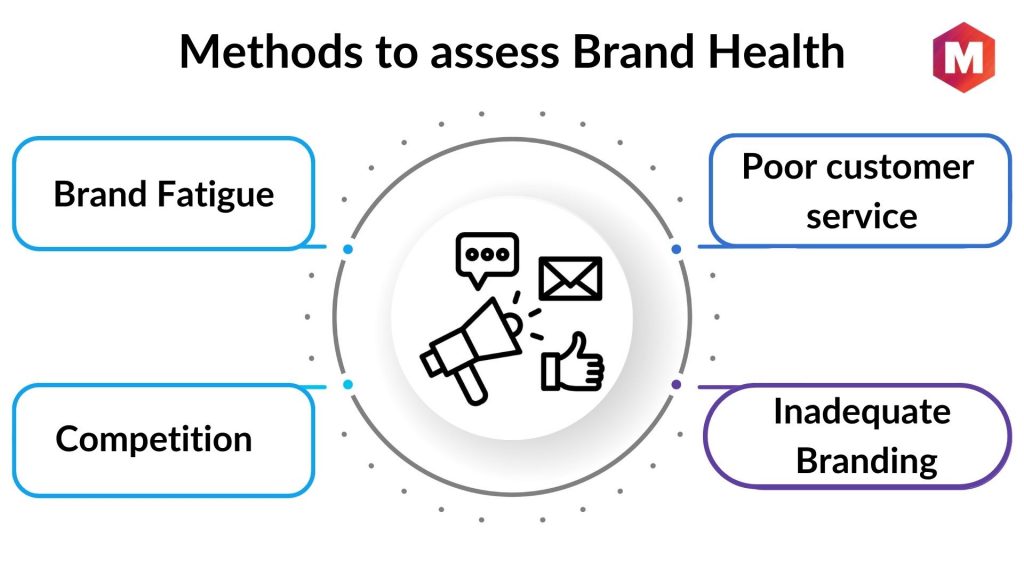
Measuring and Improving Brand Health: Essential Metrics and Methods

Brand Health is crucial for a brand's success It measures different metrics indicating the brand's overall performance, strength, and well-being Measuring Brand Health provides insights into customer sentiment, loyalty, future trends, and whether the brand is meeting customer expectations Key metrics include Brand Awareness, Reputation, Positioning, Equity, and Loyalty Effective methods to assess Brand Health include social listening, surveys, analytics, and focus groups
What is Brand Health?
Measuring brand health requires examining a variety of metrics that provide insight into a brand's overall performance, strength, and well-being. These metrics encompass factors such as brand reputation, share of voice, net promoter score, brand recalls (Prompted or Unprompted), brand equity, and purchase intent. To gauge brand health, it's important to track customer satisfaction, sales figures, market share, brand awareness, and loyalty, among other indicators.
The well-being of an organization's brand, also known as brand health, encompasses the perception of quality, trustworthiness, and credibility that customers associate with their products and services. Overall performance, market share, customer satisfaction, loyalty, public perception, web traffic, word-of-mouth referrals, and customer feedback are some of the factors and metrics used to measure brand health. It is not only a reflection of how well a brand is currently performing, but also an indication of its future success.
A strong brand is crucial as it reflects how well your current customers are satisfied with your product or service. When your brand consistently delivers on its promise and provides exceptional experiences to your customers, it helps cultivate a robust brand image.
Conducting a Brand Health Study is an effective method to assess the health of your brand and monitor it over time. By tracking your brand's health, you can identify the key factors that influence its success and make necessary changes accordingly.
Why measure Brand Health?
Some of the reasons why Brand Health should be measured are
1. Provides an overall view of a company’s success
Brand health metrics provide valuable insights into an organization's brand success by measuring its ability to meet customer expectations, outperform competitors, and accomplish long-term objectives.
Brand health metrics are essential for businesses to understand how their products and services are perceived by customers and how they interact with them. With this information, companies can identify areas for improvement and leverage customer loyalty to boost sales. In addition, brand health metrics provide valuable insights into customer sentiment, which can be leveraged to create more impactful marketing campaigns.
3. Shows future performance trends
Brand health metrics are crucial for predicting a company's success in the future. By analyzing brand health data, businesses can proactively respond to market changes and stay ahead of their competitors.
4. Indicates whether a company is meeting customer expectations
Brand health metrics are crucial for businesses to understand how their customers perceive their brand. By analyzing these metrics, businesses can identify areas that need improvement and determine if they are meeting customer expectations. This information is invaluable in developing more effective products and services that meet customer needs.
5. Provides valuable insights into customer loyalty
Brand health metrics are crucial in determining the level of customer loyalty and the ability of a business to leverage that loyalty. With the help of brand health data, companies can gain a better understanding of their target audience, which can ultimately lead to the creation of more effective marketing strategies and increased sales.
Key Brand Health Metrics to measure Brand’s Health & Brand’s Success
Some of the most important brand health metrics that can help you track if you have a healthy brand or not are
1. Brand awareness
Customers' familiarity with an organization's brand is what brand awareness measures. Metrics related to brand awareness assist organizations in assessing the effectiveness of their marketing campaigns and determining the level of recognition their brand enjoys in the market.
2. Brand Reputation
Brand reputation measures how positively customers view an organization’s brand, including factors such as customer service, products, and services.
Brand reputation metrics can provide valuable insights into how customers perceive a brand and what areas need improvement.
3. Employee engagement
Employee engagement is a crucial factor in determining the success of an organization. It reflects how motivated and satisfied employees are with their work and the company they work for. Measuring brand health metrics can help organizations assess the level of employee engagement and loyalty, and identify areas where improvements can be made.
4. Brand positioning
Rewritten: Brand positioning is a crucial factor in determining an organization's standing in the market when pitted against rivals. Companies rely on brand positioning metrics to gauge their target audience, identify their competitive edge and assess their positioning effectiveness in reaching their target customers.
5. Share of voice
Share of voice (SOV) measures how much of the total conversation in a particular market is being driven by an organization’s brand.
Share of voice metrics enable businesses to gain insights into their market presence, benchmark against rivals, and pinpoint focus areas for boosting their SOV.
6. Net promoter score (NPS)
Rewritten: The Net Promoter Score (NPS) is a valuable metric that gauges the likelihood of customers recommending an organization's brand, enabling businesses to gain insights into customer sentiment, pinpoint areas for growth, and foster customer loyalty.
7. Unprompted brand recall
Unprompted Brand Recall measures how easily customers can remember or recognize a brand without any prompting.
It can provide valuable insights into how well customers remember a brand and how it is positioned in the marketplace.
8. Brand equity
The value of a brand, encompassing its goodwill and recognizability, is measured by Brand Equity. This metric offers insights into how customers perceive a company's brand and highlights the areas that require improvement to enhance its value.
9. Time on the website
It measures the amount of time visitors spend on an organization’s website.
Time of the website can help organizations identify which pages are most popular and where they should focus their efforts to improve customer experience.
10. Returning visitors
The frequency at which customers revisit an organization's website or store after their first visit is known as Returning Visitors. This measure offers valuable insights into customer loyalty, brand recognition, and overall satisfaction.
11. Brand Consideration
Brand Consideration measures how likely customers are to consider a particular product or service from an organization’s brand.
It can help organizations understand which products are preferred by their target audience and where they should focus their efforts in order to attract more customers.
12. Brand Associations
By measuring the sentiments associated with a brand, businesses can get insights into their strengths and weaknesses, and determine what sets them apart from their competitors. This information can be used to identify areas for improvement and to enhance the brand's reputation in the market.
13. Brand Loyalty
Brand Loyalty measures how likely customers are to remain loyal to an organization’s brand.
The health metrics can provide valuable insights into customer attitude, loyalty, and perception of the brand.
14. Brand Advocacy
Understanding Brand Advocacy is crucial for businesses to gauge the likelihood of their customers to recommend their brand's products or services. This metric provides insightful information on how brand advocates can be utilized to promote and enhance customer loyalty.
15. Brand Perception
Brand Perception measures how customers perceive a brand in comparison to its competitors.
Perception metrics can provide organizations with information on what areas should be improved or emphasized to boost their public image.
16. Brand Search Volume
By monitoring the brand search volume, organizations can gain insights into how frequently their brand is being searched for on search engines. This information can be valuable in determining the effectiveness of their online marketing strategies and identifying areas for improvement to increase their online visibility.
16. Brand Sentiment
Brand sentiment measures the sentiment associated with an organization’s brand.
It can provide valuable insight into what kind of sentiments existing and potential customers have towards a brand.
17. Brand Reach
Measuring brand reach involves quantifying the audience that has been reached through various digital channels. This information can be leveraged to understand the effectiveness of a brand's digital marketing efforts and to identify areas for improvement and expansion.
18. Brand Affinity
Brand affinity measures the positive or negative feelings associated with an organization’s brand.
By analyzing customer affinity towards a brand's products or services, the brand can gain valuable insights into how to enhance customer relationships and promote loyalty.
19 Brand Engagement
Rewritten: Measuring brand engagement involves evaluating the likelihood of customers to interact with a brand through digital platforms. This evaluation provides valuable insights into the effectiveness of digital channels in engaging customers and helps identify areas that require attention to enhance customer engagement.
20. Brand Equity
Brand equity measures the overall value of a brand in the marketplace.
It is tracked by brands to understand how their brand is perceived and valued by customers, as well as the overall value their brand provides.
Effective Methods to assess Brand Health
1. Social listening
Monitoring customer feedback on social media is crucial for organizations to understand how their brand is perceived. Social listening provides a valuable metric to measure customer sentiment and evaluate brand performance across various social channels.
2. Surveys
Conducting surveys can be an invaluable tool for organizations looking to improve their brand's health. These surveys can offer valuable insights into customer sentiment, loyalty, and overall perception of the brand. By gathering this information, companies can make informed decisions and take action to strengthen their brand and better serve their customers.
Metrics that track open rates, click-through rates, and conversion rates are crucial for determining the health of a brand's marketing campaigns. By utilizing these key performance indicators, businesses can gain valuable insights into the effectiveness of their campaigns, allowing them to identify areas for improvement and optimize their strategies.
3. Marketing Campaigns
4. Customer Service
Measuring brand health metrics can be done through customer service. Key performance indicators like response times and customer satisfaction ratings can provide valuable insights into how customers perceive a brand. By gathering customer feedback, businesses can identify areas that need improvement and make necessary changes to enhance their brand.
5. Analytics
Analytics tools like Google Analytics and Adobe Analytics can help organizations monitor their brand health metrics. By providing detailed insights into website performance, customer engagement, and other important metrics, these tools allow for a thorough assessment of brand health.
6. Focus groups
Using focus groups is a highly effective way to evaluate the strength of a brand. By gaining direct feedback from customers, organizations can pinpoint specific areas that require attention or improvement, and ultimately enhance their public perception.
Potential causes for declining Brand Health
When customers see the same advertisements and messaging from a brand over and over again, they may develop brand fatigue, which can negatively impact the brand's health. Additionally, poor customer service can also play a crucial role in the decline of a brand's health, as dissatisfied customers are less likely to remain loyal and more likely to share negative experiences with others.
Insufficient Branding can lead to a decrease in brand health as it may result in customers being unaware of what the brand represents and losing interest over time. It is crucial for branding to be consistent and captivating, enabling customers to establish a relationship with the brand and comprehend its purpose.
The presence of Competition in the market can also harm brand health. Brands must distinguish themselves from their competitors to gain customer attention and set themselves apart. Neglecting to do so can result in a decline in brand health.
Brand Health Tools
To stay ahead in the game, organizations can use social listening tools such as Brandwatch, Brand24, and Hootsuite to monitor customer conversations about their brand on various social media platforms. By doing so, they can gather valuable insights on customer sentiment and assess the overall health of their brand.
Fragment 53: These tools help them identify areas of improvement and optimize their efforts for the best results.
Rewritten: By utilizing marketing automation tools, organizations can identify areas for improvement and optimize their efforts for optimal results.
Using customer feedback tools like KISSmetrics, Intercom, and Zendesk can greatly benefit businesses in tracking customer reviews, measuring satisfaction, and gaining insights into their brand perception. Such tools provide valuable information that can help identify areas where the business needs improvement, ultimately leading to better brand health. By utilizing the right tools and strategies, organizations can continuously monitor their brand health and stay ahead of the competition in the marketplace. Brand health metrics offer powerful insights into customer sentiment, allowing businesses to optimize their efforts for success.
Conclusion
Brand health is an important part of any business, as it affects the brand’s reputation and ultimately impacts its success.
It is essential to track brand health regularly to better understand how customers view your company and make sure that you are providing the best experience possible.








